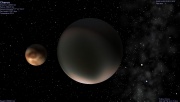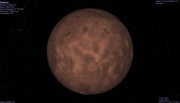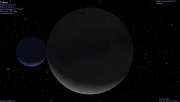Planetary Database/Terran/Kuiper Belt Objects
The Planetary Database - Terran System - Kuiper Belt Objects
The Kuiper belt (pronounced /ˈkaɪpɚ/) is an area of the Terran solar system extending from the orbit of Neptune (at 30 AU) to 50 AU from the Sun.
The objects within the Kuiper Belt together with the members of the scattered disk extending beyond, are collectively referred to as trans-Neptunian.
The interaction with Neptune (2:1 orbital resonance) is thought to be responsible for the apparent edge at 48 AU (a sudden drop in number of objects, see Orbit distribution below) but the current models have yet to explain this peculiar distribution in detail.
Over 800 Kuiper belt objects (KBOs) have been discovered in the belt, almost all of them since 1992. Among the largest are Pluto and Charon, but since the year 2000 other large objects that approached their size were identified. 50000 Quaoar, discovered in 2002, which is a KBO, is half the size of Pluto and is larger than the largest asteroid, 1 Ceres. 2005 FY9 "Zenn" and 2003 EL61 "Santa", both announced on 29 July 2005, are larger still. Other objects, such as 28978 Ixion (discovered in 2001) and 20000 Varuna (discovered in 2000) while smaller than Quaoar, are nonetheless quite sizable. Sedna, a small red planetoid with a diameter roughly half-way between Pluto and Quaoar, was first sighted on november 14th 2003. The exact classification of these objects is unclear, since they are probably fairly different from the asteroids of the asteroid belt. The largest recent discovery is 2003 UB313, nicknamed Xena. It has led scientists to question the definition of the term Planet, as it is larger than Pluto and has already been called a tenth planet by some sources.
Neptune's moon Triton is commonly thought to be a captured KBO.


